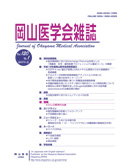

Journal of Okayama Medical Association
Published by Okayama Medical Association<Availability>
Full-text articles are available 3 years after publication.
Permalink : https://ousar.lib.okayama-u.ac.jp/19200
The Studies on Fat Embolism in the Organs at the Time of Wound Report 2 The Study on Fat Embolism in the Organs of the Animals at the Time of Wound
Kusaka, Hironao
Published Date
1959-02-28
Abstract
The author made an experimental study with guinea-pigs and detected fat embolism in the lung in the same way as the report 1. The author obtained the following results. 1) It is confirmed that the occurrence of the fat embolism in the lung were the strongest in the case of injury on bones. There was proved the fat embolism in the lung also in the case of vertebral fracture. In the case of injury on soft part tissues by incised wounds, punctured wounds, cut wounds and contused wounds, there was proved an equal slight fat embolism in the lung. 2) There was slightly high degree of fat embolism in the lung in the case of injury on head rather than in the case of injury on breast, abdomen, and hands and feet. 3) There was confirmed the high degree of fat embolism in the lung in the case when the bodies have been left for about several minutes or several hours before death after wounded than those of sudden death, and showed a decline of fat embolism in the case when the bodies have been left for about 10 hours after wounded. 4) There was proved a remarkable fat embolism in the lung in the all cases of being run over and killed, and also proved a slight fat embolism in the case of death from burns. It is thought that these detections have a deep significance as a sign of vital reaction. 5) There was nothing in the cases of death from hanging, strangulation, strangulation by the hand and death of intoxication (carbon monoxide, potassium cyanide, arsenious acid and luminal). 6) The fat embolism that have been appeared in the lung showed no change by post-mortem operations such as being run over and killed, hanging and strangulation. 7) There was not proved the fat embolism in the lung by the decomposition of dead bodies, and the substance that would be dyed red by Sudan Ⅲ.
ISSN
0030-1558
NCID
AN00032489
